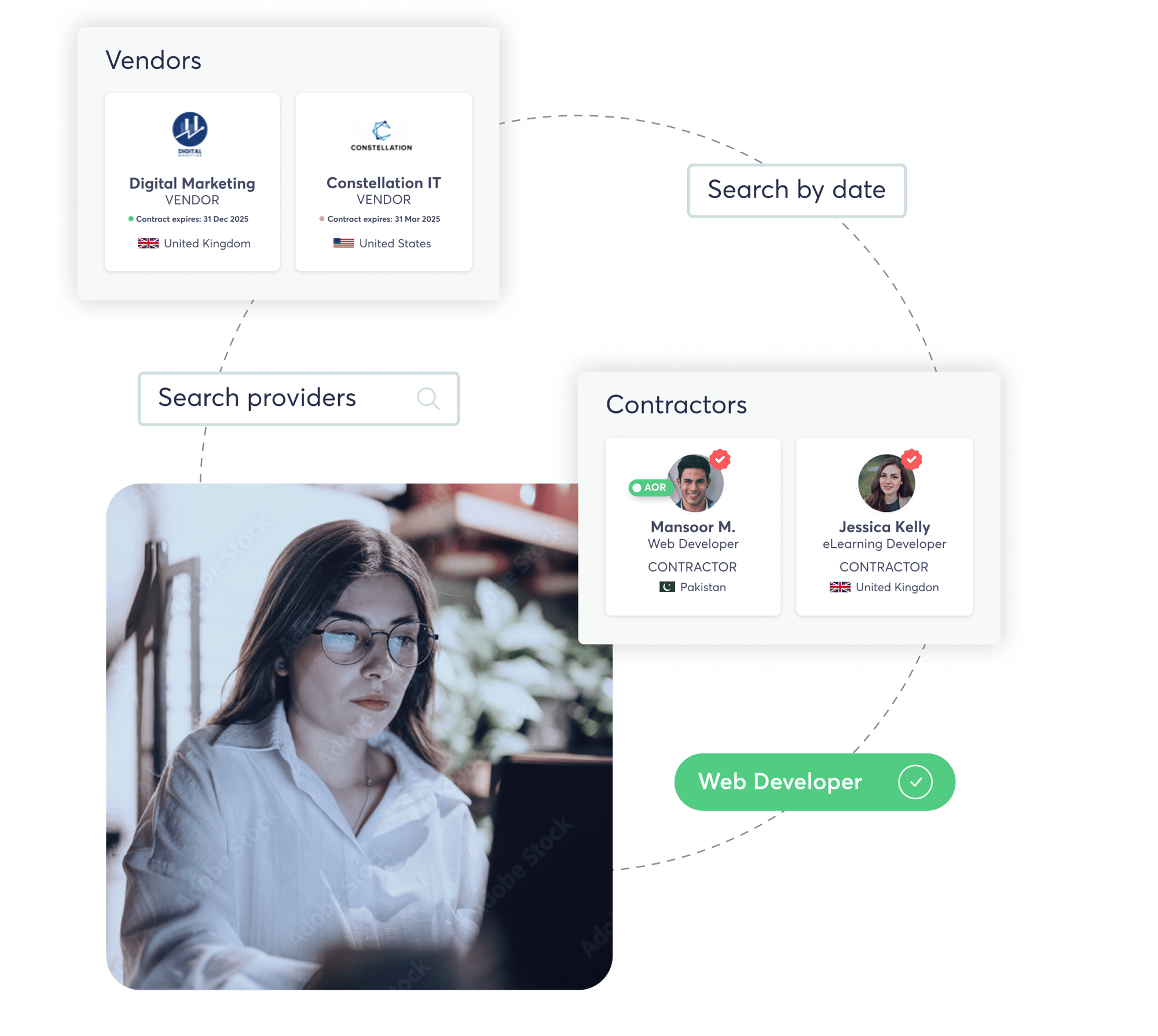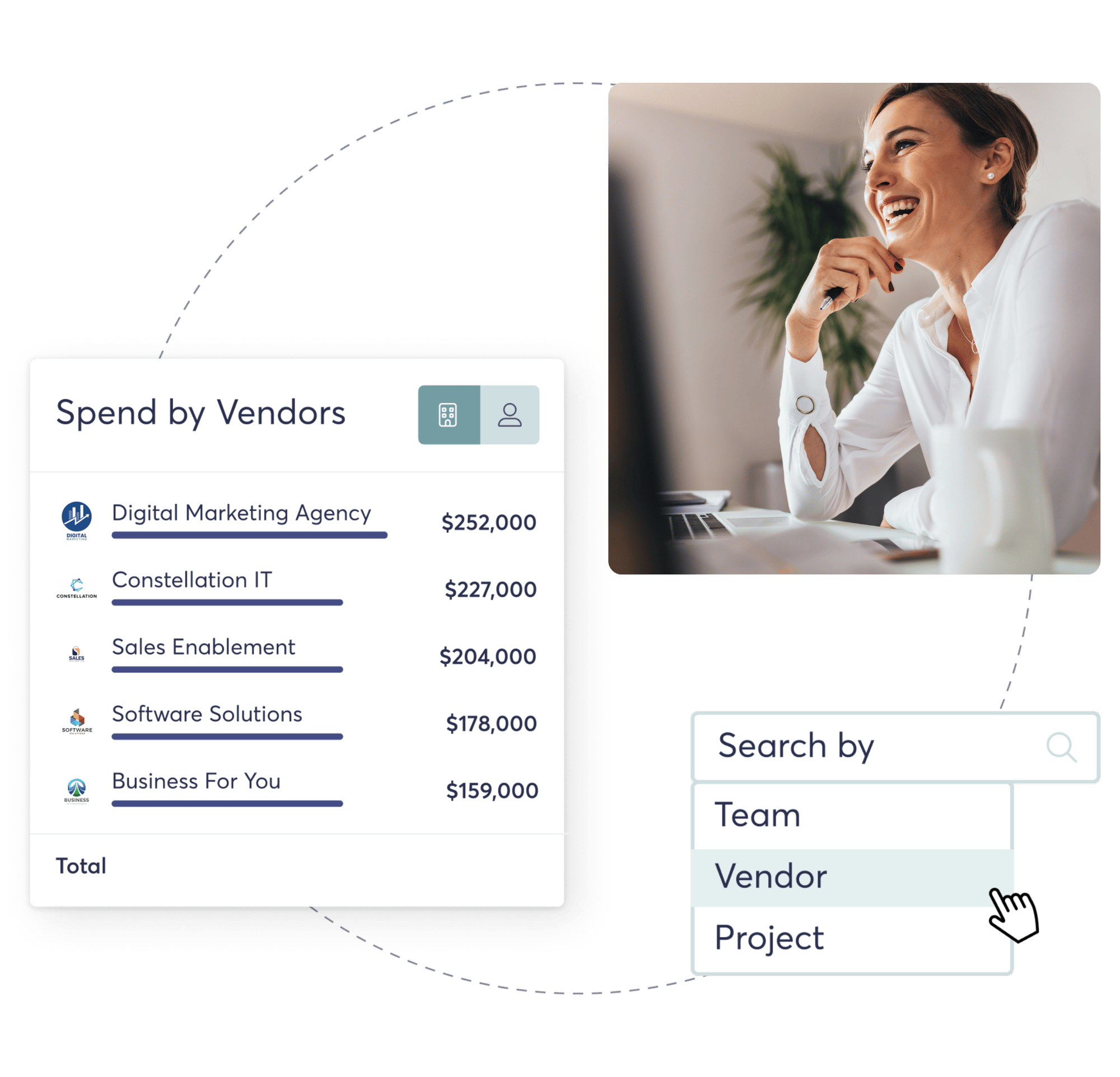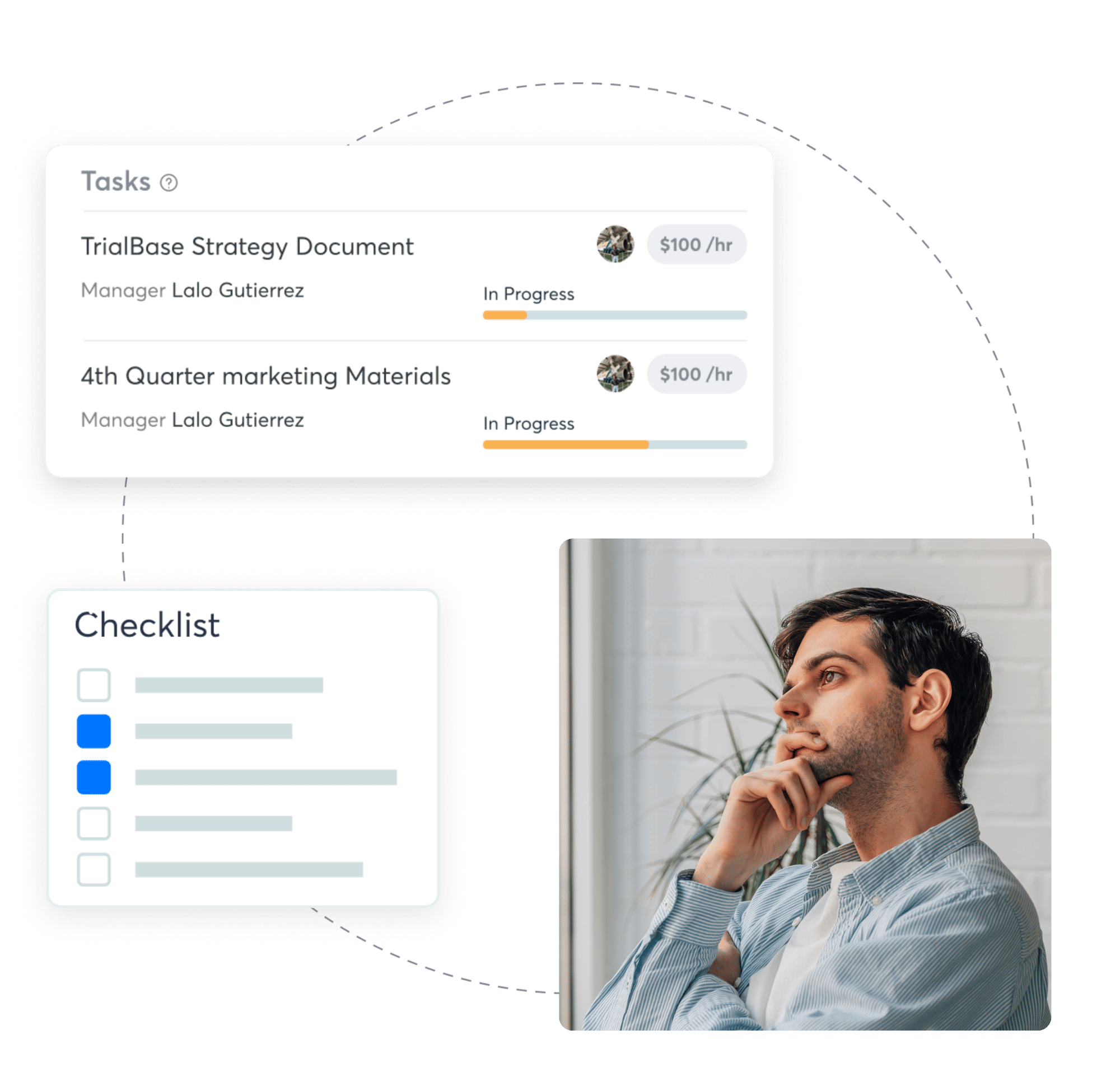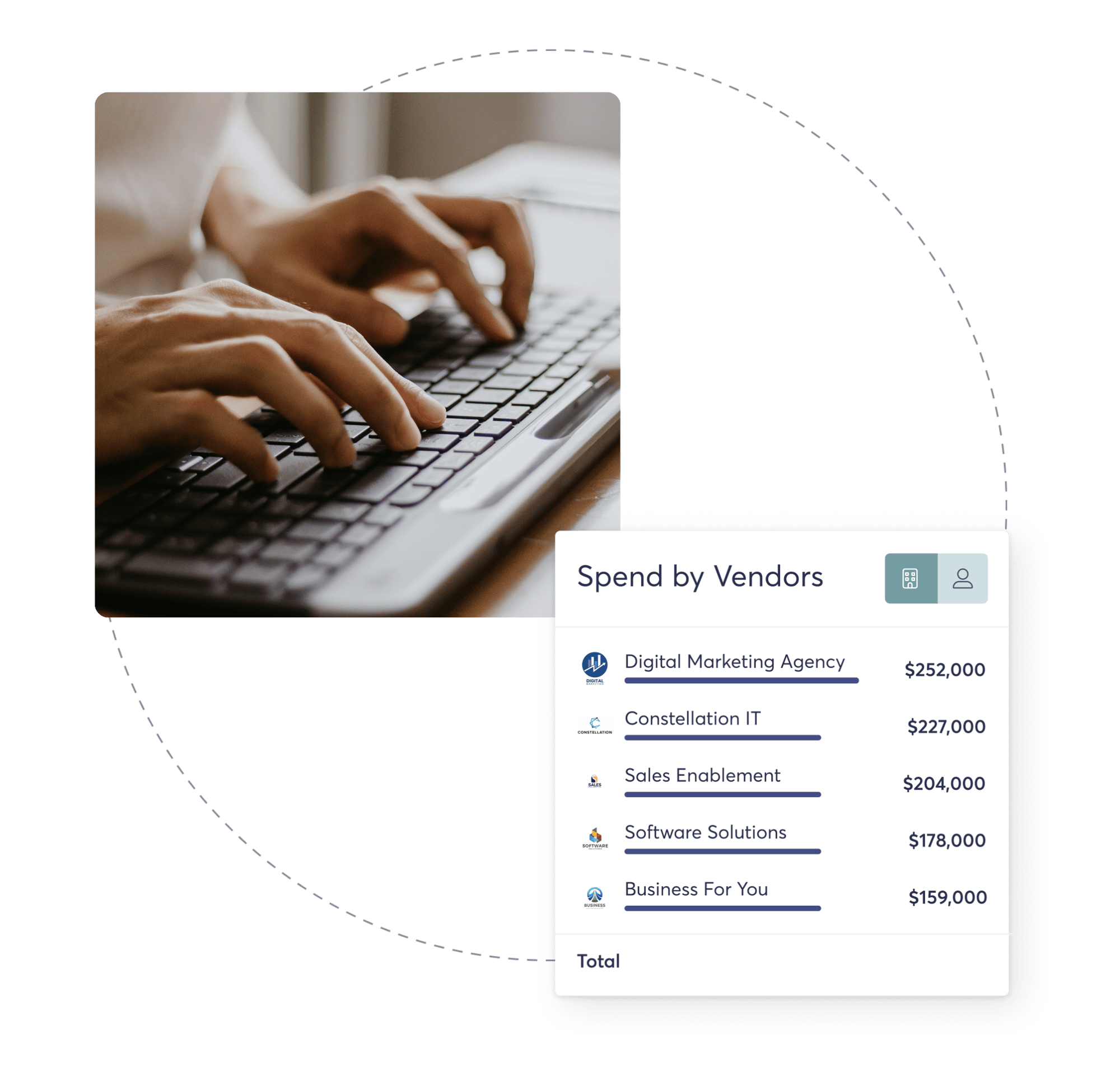Vendor Management
This collection of articles will guide you through every step of the vendor management process, ensuring each vendor engagement becomes your strongest strategic advantage!

Managing third-party vendors and talent suppliers is only a struggle when you don’t have the right processes in place.
Think about what working with a single talent vendor involves – tracking contracts, compliance risks, data, payment information and more. Now add in a few more vendors (each with a host of freelancers and contractors under them) and you’ll know how fast the work spirals.
Managing vendors without organization and visibility can lead to inefficiencies, risks, and missed opportunities. Without structured processes and systems, teams end up reinventing workflows with each new vendor that comes on board – and then scramble to find data, manage relationships and track performance.
In this guide, we aim to change that. From selecting vendors to onboarding them, monitoring performance, and managing compliance, these resources will help you streamline your processes, end-to-end. Step into a world of consistent, transparent and highly optimized vendor management!
Table of contents
- How it works: vendor management
- What is vendor management
- What is a vendor management system
- Freelancer Management System (FMS) vs Vendor Management System (VMS)
- Vendor Selection Best Practices: How to Choose the Right Supplier
- Contract Management in Vendor Relationships
- Vendor Onboarding Checklist
- Vendor Risk Management – How to Identify, Assess & Control Third-Party Risks
- Vendor Risk Management: How to Identify and Control Third-Party Risks
Vendor Management: How it works
Read more
Vendor Management: How it works
Ready to build your own successful vendor strategy? First, find out how vendor management works. It doesn’t involve a single spreadsheet, we promise!
Instead, this page breaks down exactly what steps you will need to plan for – right from vendor selection to payments – and outlines what helps at each step of the process. With practical tips and the right system support, it shows you how simple vendor management really can be!
👉 Read: Vendor Management: How it works to discover how you can optimize your workflows.
What is Vendor Management and how does it help?
Read more
What is Vendor Management and how does it help?
Managing vendors well is the key that unlocks cost savings, agility, and innovation. And every step of the vendor lifecycle has a role to play here.
This is your go-to guide for understanding how to optimize each step – from sourcing to onboarding; from strengthening relationships to managing risks. The process has its own intricacies so the guide also offers insights on how to overcome the challenges you might come up against.
By the end of it, you will be able to build a winning vendor management strategy that works for you – even as you scale up. Done right, it’s going to be your greatest competitive advantage!
👉 Read the full guide on Vendor Management to explore the step-by-step process of creating a smarter vendor strategy.
What is a Vendor Management System (VMS)? A Complete Guide
Read more
What is a Vendor Management System (VMS)? A Complete Guide
Trying to handle vendor management processes manually is the easiest way to get overwhelmed and use up all your free time! A Vendor Management System (VMS) is a powerful tool that ensures this does not happen.
Read this guide to know what a VMS does, what are the key features you should look for, and how to go about choosing the right one for your needs. Plus: It also tells you the challenges involved in implementing a VMS – and gives you a list of the best tools in the market today.
👉 Read: What is a Vendor Management System (VMS)? A Complete Guide to understand how the right VMS can simplify vendor relationships.
Freelancer Management System (FMS) vs Vendor Management System (VMS)
Read more
Freelancer Management System (FMS) vs Vendor Management System (VMS)
Do you need an FMS or a VMS? Or are they the same thing?
Short answer: No, they are not the same. The two tools serve very different purposes – and the difference has to do with the kind of external workers you are engaging (freelancers vs. vendors).
This article explains the key differences between the two tools, highlights the benefits and complexities of each, and helps you decide which one might be more appropriate for your specific requirements. It helps you establish the right processes that will work for your business needs over the long term!
👉 Read: Freelancer Management System (FMS) vs Vendor Management System (VMS) to compare both platforms and choose the right one for you.
Vendor Selection Best Practices: How to Choose the Right Supplier
Read more
Vendor Selection Best Practices: How to Choose the Right Supplier
The best talent vendor is not always the one that comes at the lowest price! So what are the other factors you need to consider?
This handy guide tells you what to look for in a great vendor and shows you how to put together a fair, structured vendor selection process. By the end of it, you will be able to:
- Shortlist the factors that matter to you
- Know how to evaluate vendors in objective, measurable ways
- Spot vendor red flags and sidestep risks
- Put together checklists, scorecards and templates to help you with the process
👉 Read the full article on How to Choose the Right Vendor or Talent Supplier to build a vendor selection process that will make the engagement your next strategic advantage.
Contract Management in Vendor Relationships
Read more
Contract Management in Vendor Relationships
Once you have selected the right talent vendor, it’s time to talk contracts. And no, it does not have to be as complicated as you may be thinking!
This is your comprehensive guide on how contract management protects you against compliance risks, what clauses a good vendor contract should include, and how you can negotiate for the best vendor outcomes.
Bonus: It gives you the full contract lifecycle workflow, chalking out exactly what should be done at each stage and who should be involved. It also tells you how you can automate the process.
👉 Read the full article on Vendor Contract Management to get step-by-step guidance and learn the best practices to safeguard your business, improve vendor accountability and make the engagement compliant, efficient, and future-ready.
Vendor Onboarding Checklist: Best Practices for Compliance & Seamless Integration
Read more
Vendor Onboarding Checklist: Best Practices for Compliance & Seamless Integration
Once you’ve chosen your ideal talent vendor, the next step is onboarding, and yes, it can be far simpler than you think!
This is your step-by-step guide to building a structured onboarding process that keeps your projects compliant, your teams aligned, and your vendors accountable. You’ll learn exactly what a vendor onboarding checklist should include, how to coordinate across departments, and why automation is the secret to faster, error-free onboarding.
Bonus: It walks you through the full onboarding workflow, clarifying what needs to happen at every stage, who owns which part of the process, and how to integrate compliance and documentation seamlessly. You’ll also discover how automation tools can drastically reduce onboarding time and improve visibility across teams.
👉 Read the full article on Vendor Onboarding to learn how to set up a standardized, scalable process that minimizes risk, ensures compliance, and helps your projects kick off faster and smoother every single time.
Vendor Risk Management: How to Identify and Control Third-Party Risks
Read more
Vendor Risk Management: How to Identify and Control Third-Party Risks
Managing third-party vendors doesn’t have to feel overwhelming or reactive. With the right Vendor Risk Management (VRM) strategy, you can stay ahead of potential issues long before they impact your operations, compliance or reputation. This guide walks you through the essential components of an effective VRM framework, from understanding the major categories of vendor risk to building a structured assessment process and implementing strong, proactive mitigation strategies.
You’ll learn how to evaluate vendors more accurately, reduce blind spots, monitor risk signals continuously and strengthen your overall third-party ecosystem. Plus, this guide highlights how modern automation and visibility tools can streamline your workflows, ensure consistent compliance and help your teams collaborate more confidently.
👉 Read the full article on Vendor Risk Management to discover how to protect your organisation from third-party threats.
Vendor Performance Management: Essential KPIs & Strategies for Procurement Teams
Read more
Vendor Performance Management: Essential KPIs & Strategies for Procurement Teams
Maximize vendor value by implementing a structured Vendor Performance Management (VPM) strategy. This guide details the essential Key Performance Indicators (KPIs) you must track - covering compliance, cost, risk, and innovation - to eliminate guesswork and ensure accountability. Learn how to establish objective metrics pre-contract and conduct data-backed reviews.
The article also highlights how automation tools can centralize data, provide real-time performance dashboards, and streamline monitoring. Adopt this proactive VPM framework to objectively measure success, build strategic vendor relationships, and optimize your external workforce.
👉 Read the full article on Vendor Performance Management to discover how to objectively measure success and optimize your external workforce.
Frequently asked questions
How can businesses improve their vendor management process?
Improving vendor management starts with visibility and consistency. Businesses should centralize all vendor data, automate manual tasks like onboarding and invoicing, and define clear KPIs to measure performance. Using a Vendor Management System (VMS) allows you to track compliance, spend, and project outcomes in one place, reducing risks and improving collaboration. Regular performance reviews and transparent communication also strengthen long-term vendor relationships.
What are the biggest challenges in managing multiple vendors?
When managing several vendors at once, common challenges include inconsistent communication, overlapping contracts, data silos, and lack of visibility into performance or compliance. These issues often lead to delays, increased costs, or compliance risks. A structured vendor management framework supported by technology can help standardize processes, streamline payments, and ensure accountability across all vendors.
Why should companies use a Vendor Management System instead of manual tracking?
Manual tracking through spreadsheets or emails quickly becomes unsustainable as your vendor network grows. A Vendor Management System (VMS) provides automation, real-time reporting, and centralized dashboards to monitor every stage of the vendor lifecycle. This helps teams save time, maintain compliance, and reduce costly errors, while offering full visibility into vendor performance and spend.
How does vendor management impact cost savings and business efficiency?
Effective vendor management directly contributes to cost savings and operational efficiency. By comparing vendor performance data, businesses can negotiate better rates, eliminate redundant suppliers, and reduce administrative workload. It also ensures projects are delivered on time and within budget, leading to stronger ROI and improved agility. Over time, well-managed vendor partnerships can drive innovation and long-term growth.
